
We stand with Ukraine and our team members from Ukraine. Here are ways you can help

A Community Of Over 800,000

Creating an Online Learning Platform for an Education Company — UX Case Study
- March 24, 2021
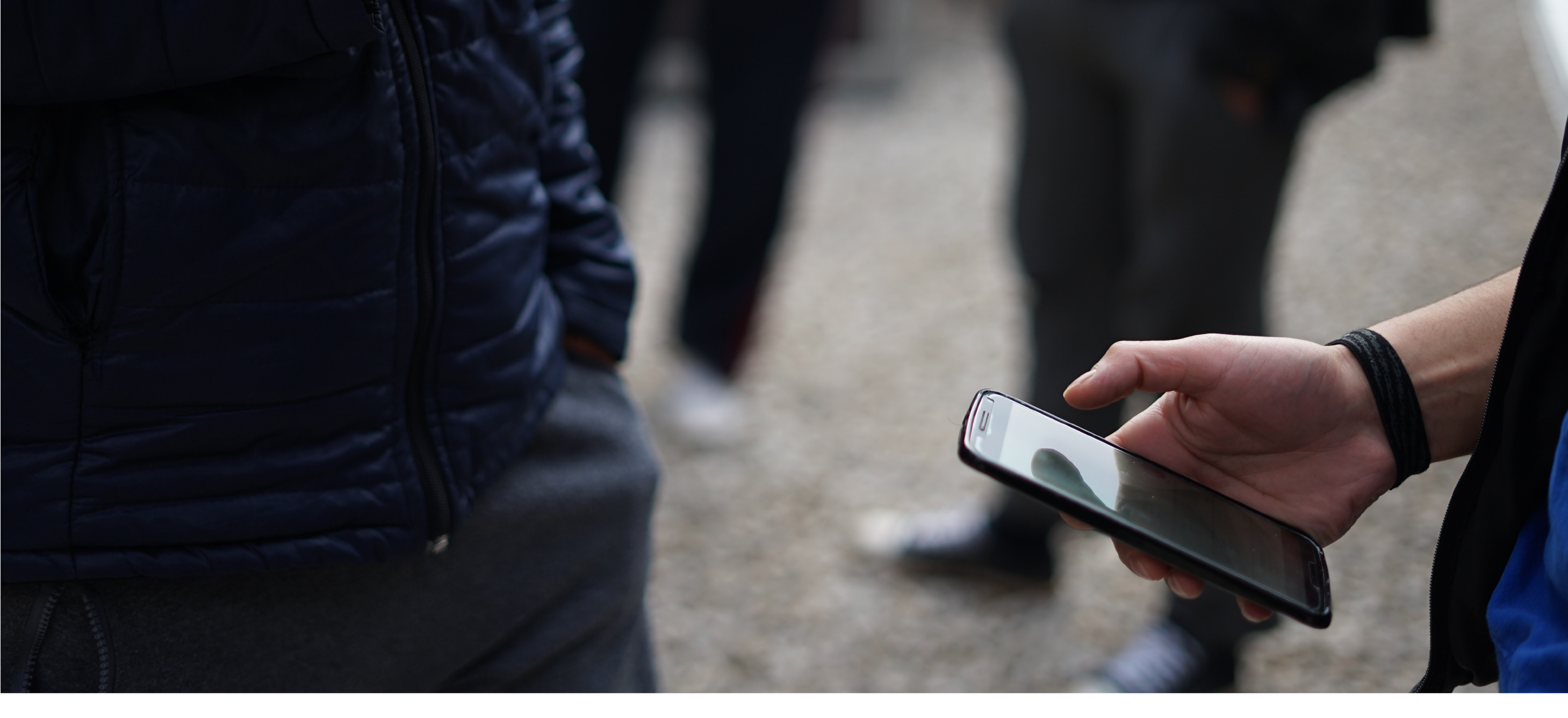
How one UX designer approached conducting research and determining the customer journey to create an engaging experience for teenagers.
Smart People, Inc. is an education company offering in-person language courses to teenagers. Their main attraction is a summer camp where students partake in collaborative activities to learn English or Spanish as a second language. However, many students are unable to attend the summer camp due to cost and time reasons but still want to access the curriculum. As a result, Smart People, Inc. wants to offer an online learning platform to students that cannot attend the summer camp in person.
Competitive Analysis
Analyzing the space that Smart People, Inc. was trying to enter, there seemed to already be a large number of competitors that dominated various areas of the Online-Learning-Platform Market.
A few dominant companies stood out: – DuoLingo is a language-learning platform focused on gamification – MarcoPolo is a STEAM-focused platform also utilizing gamification – Lynda utilizes traditional video lecturing to teach technical skills – GoFluent utilizes video lecturing to teach business skills – Tandem is an app linking native language speakers through video chat – Preply is a private tutor platform
In order to accurately gauge what area of the market Smart People, Inc. should enter, I ranked these six companies using a Market Positioning Chart.
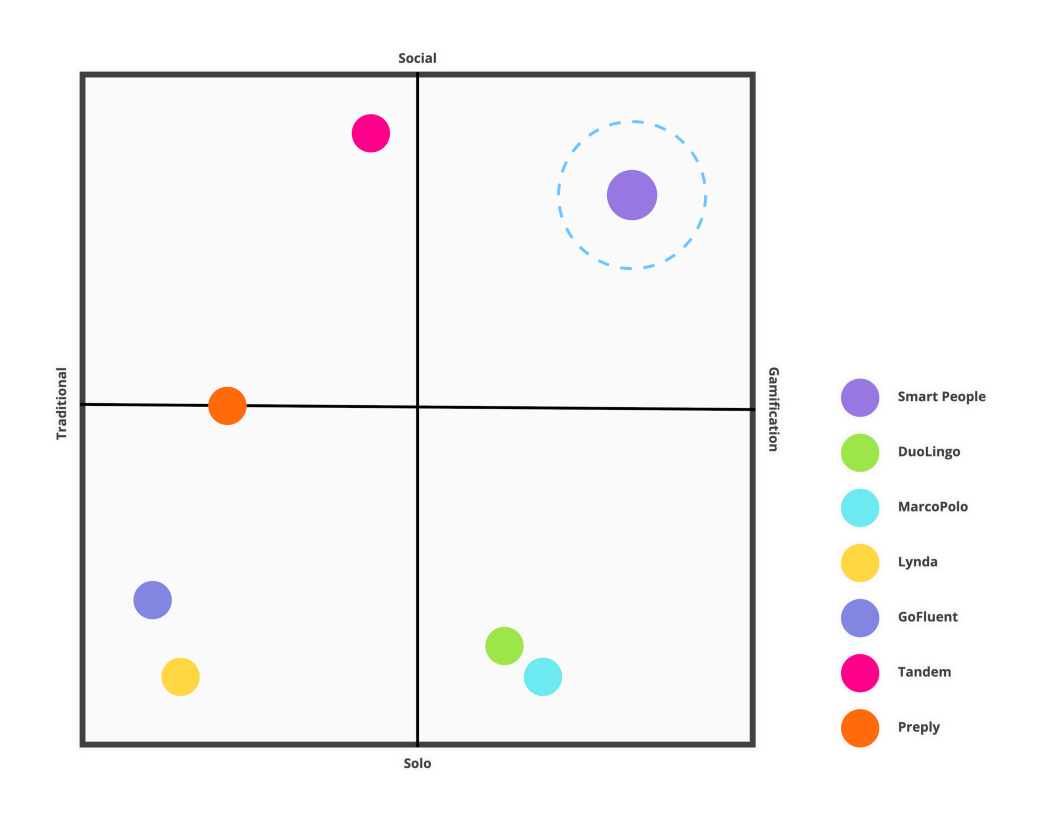
Based on the competitors’ business models, I was able to segment companies based on two variables, Traditional vs. Gamification and Social-Learning vs. Solo-Learning. As is visible from the chart, there is a huge gap in the market where Gamification and Social-Learning collide, and as such, this is the “Blue Ocean” that Smart People, Inc. should target.
User Research
With only about a day to gather insightful data about the exact consumer that Smart People, Inc. should target, I set out to learn as much as I could. I focused my research on teenagers’ relationships with the following: learning during school, learning through online platforms, and learning a new language.
Quantitative Data
Below are some of the prominent statistics that really capture teenage sentiment: – 36% of teenagers sited boredom as the number one reason they disliked school – 90% of teenagers don’t complete all their online coursework – 40% of teenagers think learning vocabulary is hard
Qualitative Data
After interviewing a few teenagers, the following quotes really stood out: – “I just don’t know why I need to learn Spanish. I’m never going to use it.” – “We just end up texting or snap chatting when we’re stuck on a problem.” – “Just black text over a white background.” – “If I get stuck, there’s like no one to help me. It’s a lot of extra work.”
Data Synthesis
Feeling confident in my research, I dissected and organized it using an affinity map. From the map, I pinpointed recurring themes and defined the target users’ pains and gains.
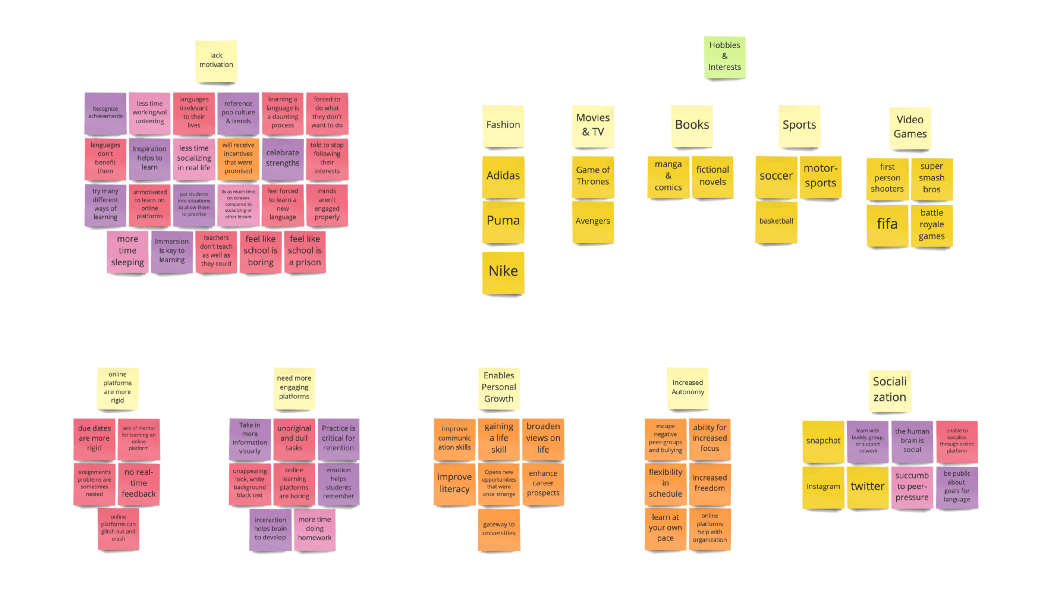
Pains & Gains
Top Three Pains: – Learning a Language is Daunting & Irrelevant – Online Platforms Lack Social Connection – Current Learning Methods Lack Engagement & Stimulation
Top Three Gains: – Languages Enable Personal & Career Growth – Online Platforms Allow Greater Autonomy – Working Outside of School Allows Increased Focus and Organization
User Persona & Their Journey
The picture that the research painted really brought to light how unmotivated the average teenager is when it comes to both school and learning languages in general. They love to hang out with their friends (whether online or in-person), play video games/sports, and watch “TV” (Twitch/Netflix/YouTube). By contrast, they find school boring and think languages are both difficult to learn and irrelevant to their lives. From this, I crafted my persona, Demotivated Dean.
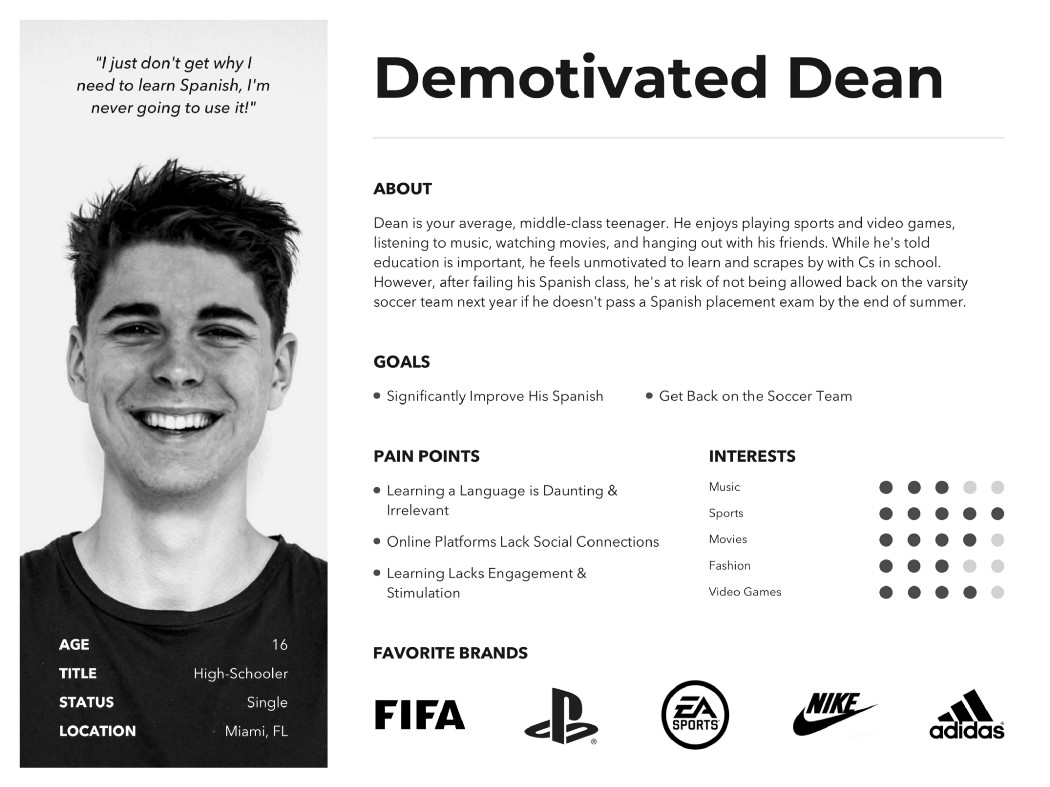
After bringing Dean to life, I put together a User Journey Map. To do so, I honed in on the data to see what an average school day looks like for Dean. I made sure to focus on his pains to really imagine what he feels while he’s sitting in class bored or struggling to finish his homework after school.
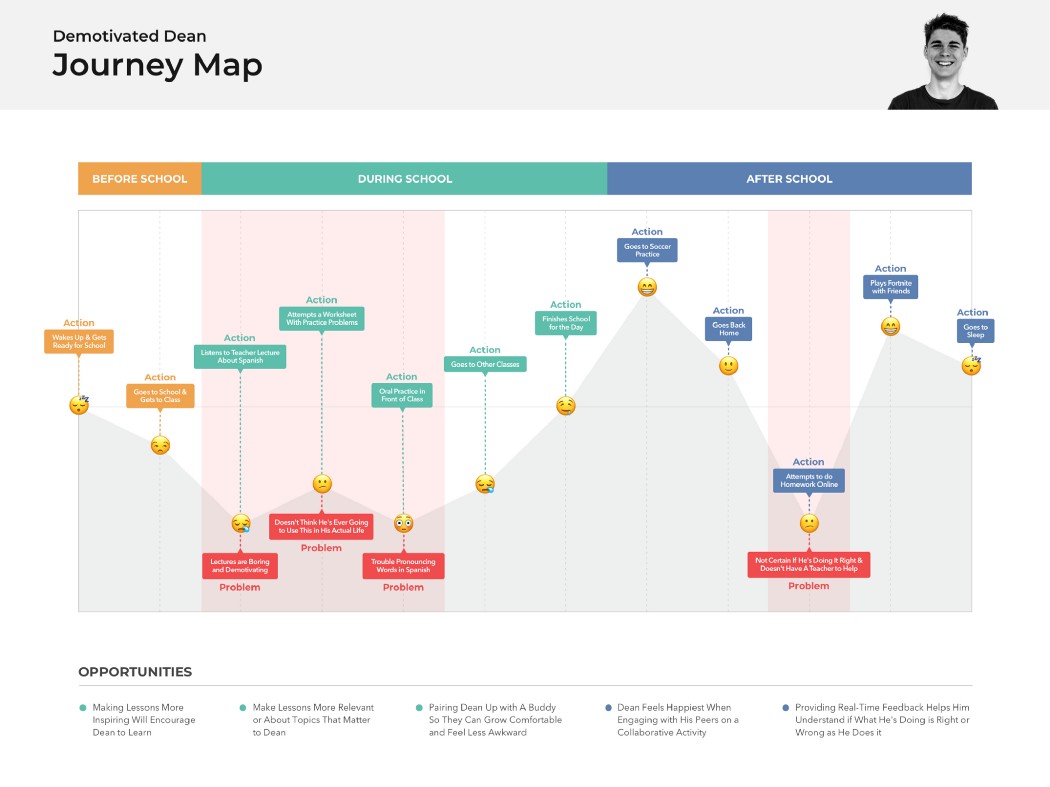
After breaking down his daily struggle, it became a lot clearer where the opportunities for design were. This leads me into ideating how the new platform could truly help Dean.
Ideating on Possible Solutions
My ideation session began by reversing Dean’s pains and turning them into How Might We statements. I then used these to come up with different ways to aid the specific issues.
- How might we help unmotivated teenagers feel more engaged and stimulated while learning
- How might we help unmotivated teenagers feel less overwhelmed while learning a new language?
- How might we help unmotivated teenagers create a social connection over online learning platforms?

After producing about 15 or so ideas for each statement, I then began grouping them into related topics. This gave me a list of possible features that I could include in my online platform.

While many of these features offer different forms of value to Dean, I set to weed out the most valuable ones. I did this by organizing the various features using the MoSCoW Method.
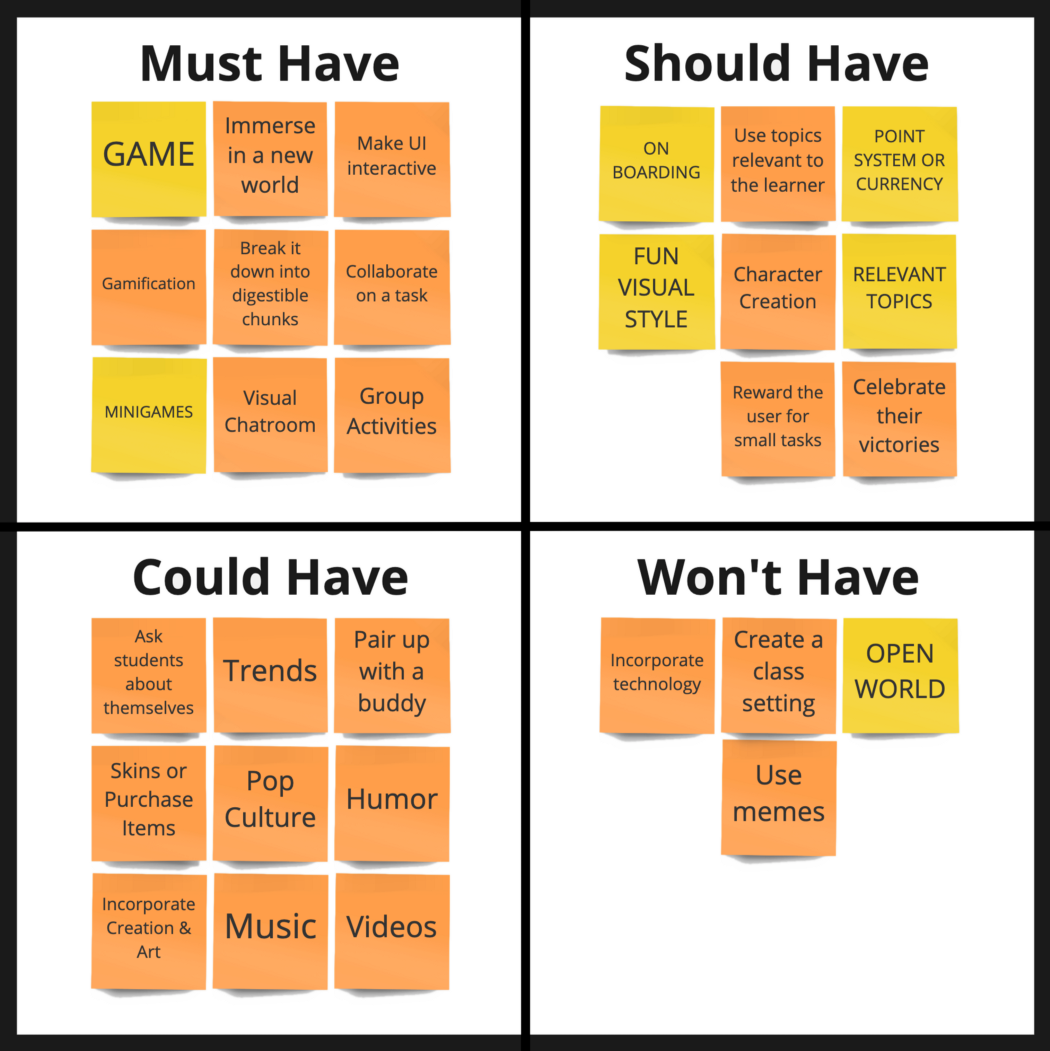
Considering that the biggest pain point was a general lack of engagement and stimulation, I judged gamification as the feature that offered the most value, followed by social interaction.
My Proposed Solution
As is visible from the data, schools and traditional online learning platforms are failing to engage teenagers. As a result, they aren’t motivated to learn, much less learn a new language, which they find irrelevant and daunting.
As a side note, gamification is an educational approach to motivate students to learn by using game elements in a learning environment. Its main benefit is that it maximizes enjoyment and engagement by captivating the student and inspiring learning. Tying this in with the social and competitive aspects that teenagers already seek, it seems a fitting solution to Dean’s struggles.
Thus to create an online learning platform that actually engages and stimulates teenagers to learn a new language, I propose an immersive game world where the user learns through collaborative mini-games and exploration over various levels.
Mapping Out the User’s Interaction
Running with this idea, I laid the groundwork in order to bring it to life. I began by constructing the Site Map in order to visualize how the level-structure would work. I then mapped out the User Flow for the user’s interaction from the moment they log in to the moment they complete a level.
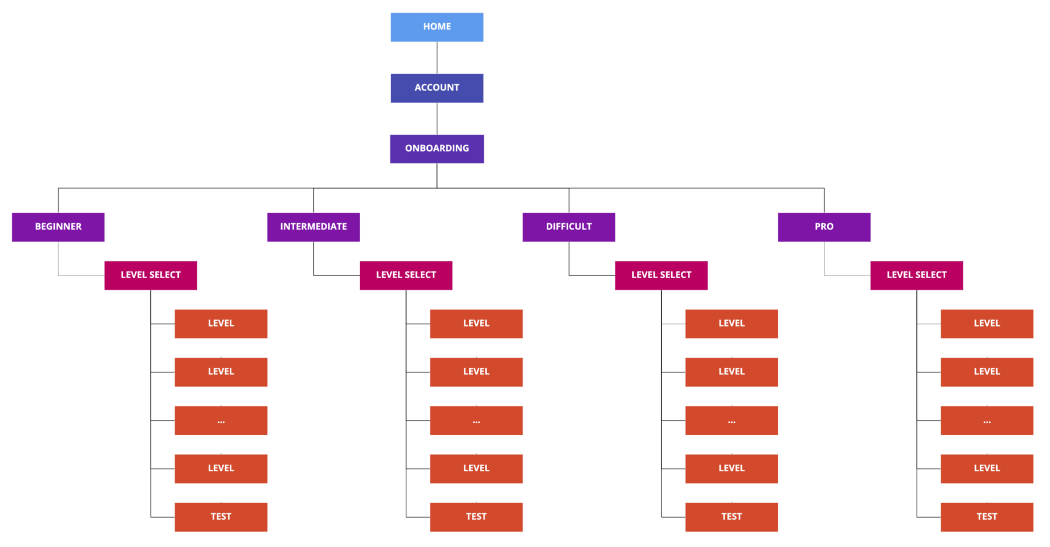
Sketching Out & Testing the Concept
Relying on the Site Map and User Flow, I sketched out Lo-Fi wireframes of the product.
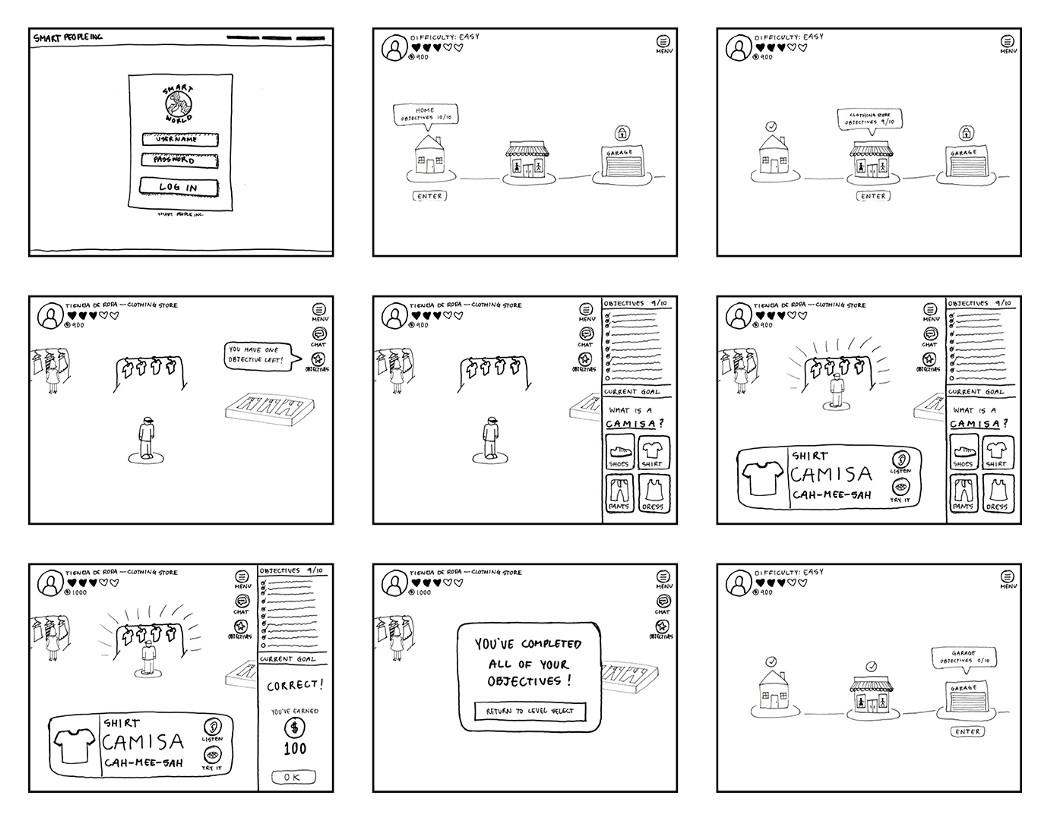
To help me catch some of the usability errors, I prototyped the hand-sketched wireframes. I then imported them into the maze.design for heating map the different screens, and capture other data. Altogether, I ran five tests.
The testing was comprised of three tasks: 1. Login and select a level that has not been completed yet. 2. Find out what your objective is and find the required item. 3. Complete the objective and return to the level select screen.
During the testing, I caught two major issues. The first occurred early on, as 2 out of the 5 testers had difficulties easily identifying incomplete levels. They were confused by the inconsistent check-marks and vague wording.
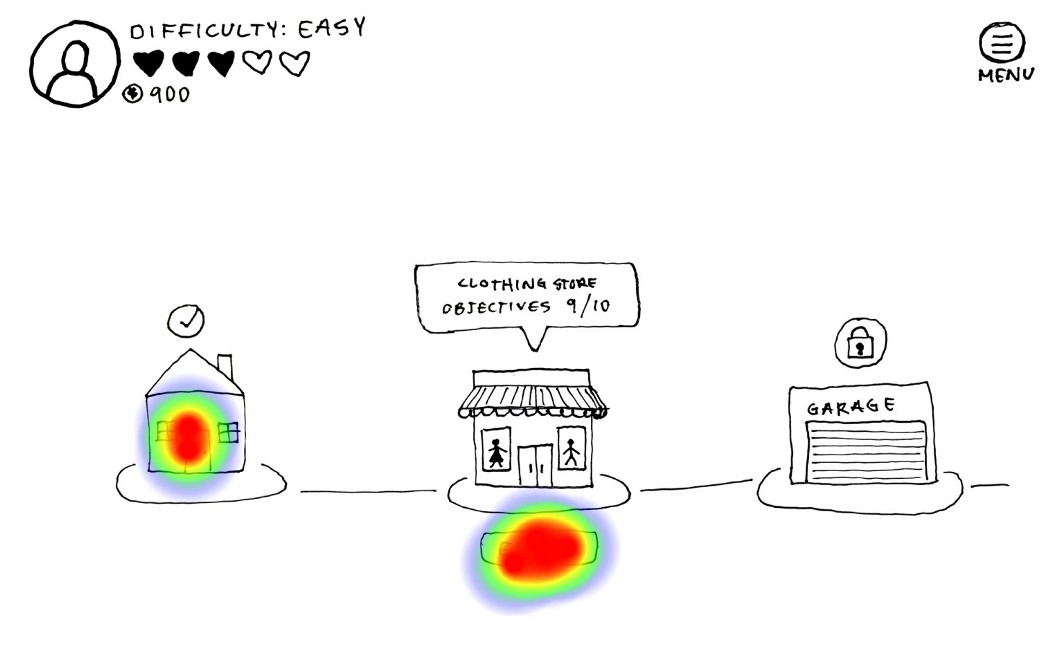
The second and more impactful issue happened during the second task. Here all five testers either hesitated or were downright confused by what they had to do. Instead of reading their objective and returning to the game to complete it, they were instantly trying to guess the answer and would ignore the exploration portion of the game.
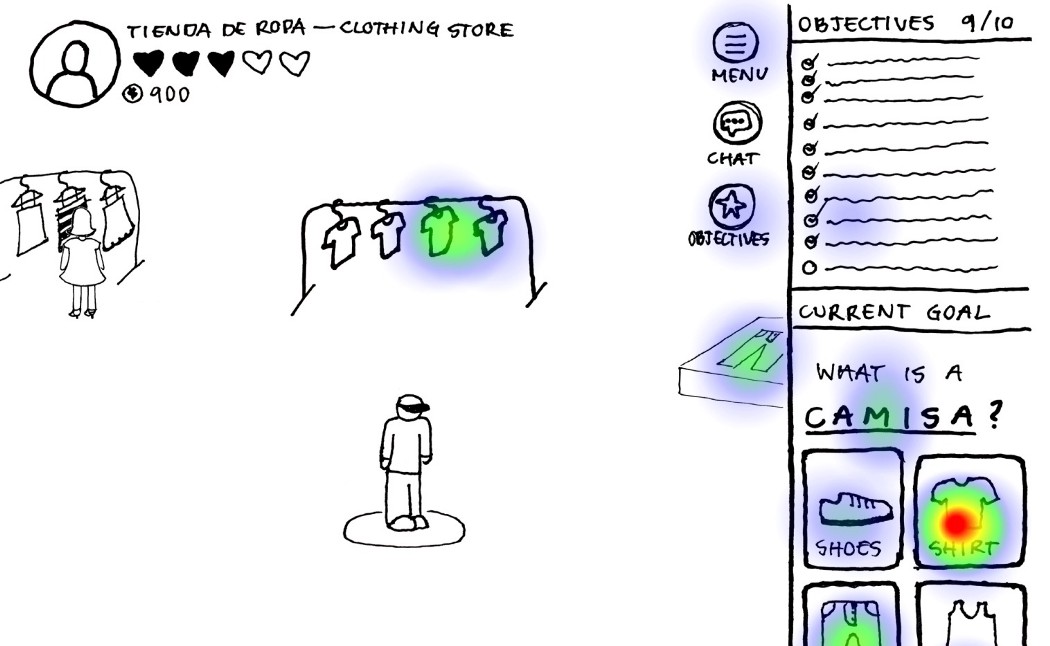

Mid-Fidelity Wireframes
Focusing on the new data insights, I made some changes to the design when making the Mid-Fi wireframes. I cleared up the confusion with the checkmarks and vague wording on the level select screen, as well as tweaked the game model to make the objectives (now called goals) less quiz-like and instead added a quiz at the end of the level to compensate and ensure the users are learning.
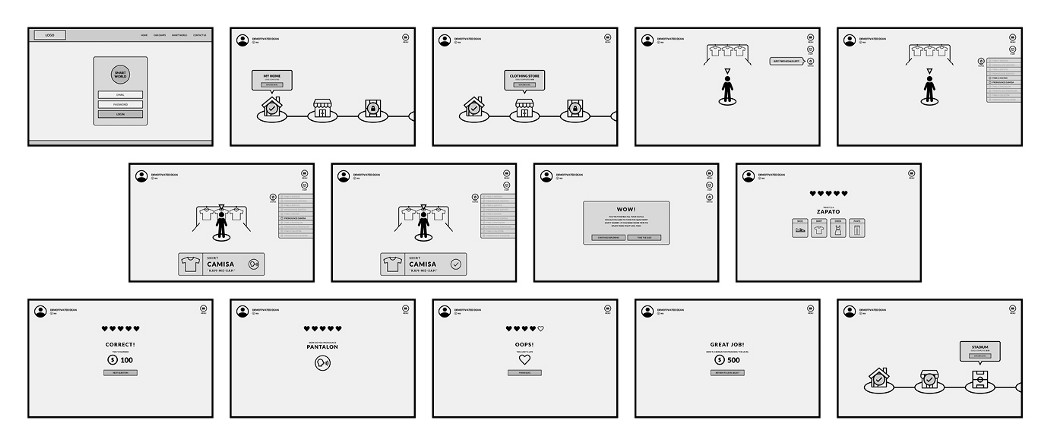
The mid-fidelity prototype can be viewed here: https://invis.io/DNRMVKJSARP .
From here, I would like to continue to test the interaction between the game world and the user interface, making sure that they flow together whereby the interface boosts the experience of the game and doesn’t fixate the user. In addition to this, expanding the functionality to include mini-games and user collaboration would be optimal to the goal of the product.
As the game continues to develop, I would measure the time it takes users to complete each level’s goals to make sure the goals aren’t too time-consuming or ineffective at teaching. I would also measure whether or not the quizzes at the end of each level can be passed within a reasonable amount of attempts.

Alvaro Gil , I’m a human-centered designer with years of experience in visual design. I thoroughly enjoy bringing products to life, starting with people’s needs and ending with stunning interfaces that are as impactful as they are a joy to use.
Related Articles
The emergence of reasoning in artificial intelligence.
- The article explores the landscape of reasoning in AI, delving into its types, challenges, and future directions, highlighting the crucial role of knowledge graphs and diverse evaluation metrics.
- The author emphasizes the need for safe, ethical, and multilingual development in the evolving field of artificial intelligence.
Share this link
- January 16, 2024

With UX and AI, Context is Everything with Sarah Gibbons and Kate Moran of Nielsen Norman Group
- Artificial Intelligence , Generative AI , Things UX People Like , UX Education , UX World Changing Ideas
- January 18, 2024
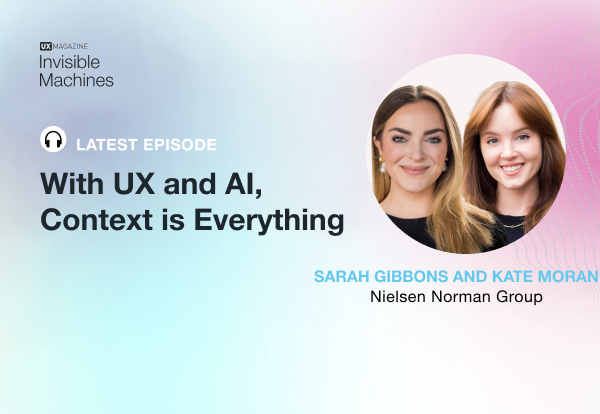
A Pattern Language
- Agile and Iterative Process , Design , Design Theory
What do Architecture, Computer Science, Agile, and Design Systems have in common?
- The article explores Christopher Alexander’s impact on diverse fields, from architecture to software development, introducing the concept of design patterns and their influence on methodologies like Agile and the evolution of Design Systems.

Did you know UX Magazine hosts the most popular podcast about conversational AI?
Join 740,000 designers, thinkers, and doers.
This website uses cookies to ensure you get the best experience on our website. check our privacy policy and.

UI UX Case Study On E-learning Mobile App

SKILL LEARNER is a online based educational learning app where people can find different kinds of courses or scope to educated themself to be ski Read More
Creative fields.

Product Design
- E-learning App
- mobile app design
- Online course
- Online education
- presentation
- UI UX Case study
- UX Case Study
- UX Research
No use is allowed without explicit permission from owner

IMAGES
COMMENTS
EduNow is an e-learning mobile application that provides courses from different fields for self-study students or full-time employees who want to sharpen their skills for their jobs. It has a modern, clean and very detailed UI design. You can easily customize the screens, allowing for great flexibility and ease-of-use when it comes to putting ...
Understanding the Problem : 1. It is difficult for first time users to trust the platform to pay for a course. 2. Existing users don't generally search on the same site for their next course. I've interviewed 10-15 people, ranging from people who have no experience in using the paid learning platforms to frequent users.
3. Over time we as humans have the desire to continue our growth and improve ourselves. Learning new skills is part of that growth. One way we can learn is through e-learning platforms and online courses, which is where Stoday comes into play. As part of Skilvul Virtual Internship, we were challenged to create an educational mobile application ...
User Research & Contextual Inquiries. We established the two primary users of Ignite e-learning are the learners (young sales professionals) and monitors (sales managers). We also conducted 4 ...
UX/UI Case Study: STEPLY, e-Learning App. Learning new skills online has been an activity that has rapidly increased during this global pandemic. People started for fun, challenge or personal growth, but the objective is clear: Learning or improving a skill. My goal is to create an e-learning app that facilitates the user the learning process.
A few dominant companies stood out: - DuoLingo is a language-learning platform focused on gamification. - MarcoPolo is a STEAM-focused platform also utilizing gamification. - Lynda utilizes traditional video lecturing to teach technical skills. - GoFluent utilizes video lecturing to teach business skills.
Download on the App Store Get it on Google Play English Čeština Dansk Deutsch Español Français Italiano Nederlands Norsk Polski Português Pусский Suomi Svenska Türkçe 日本語 한국어 中文(简体) 中文(繁體)
Product Design,App Design,UI/UX,Figma. E-Study - An online learning platform UX Case Study
Smart Watch- UIUX Case Study. Multiple Owners. 53 477. Live NGO Website Redesign- UIUX Case Study. Multiple Owners. 66 764. Pet Care App- UI/UX Case Study -FloofUP. Ankitaa Das. 90 886.
RSD Courier and Parcel delivery UX Case study. Multiple Owners. 113 1.7k. RSD Courier Website Landing Page Design. Awlad Hossain. 27 606. Thief Guard App Design. Awlad Hossain. 5 74.
Or ask students to message you to intimate you about their presence in the class. The app is designed in such a manner that whenever students join your class automatically the details are logged in a spreadsheet that you can download by clicking on the tab. No more wasting the time. 4. Uploading the assignments.
A test was taken by 54 students at MSU before and after 12 weeks of studying Spanish through Babbel. Surprisingly, the level of oral proficiency, grammar, and vocabulary correlated with how long students used the app. The more time spent on the app, the higher the scores. One downside to this study was that 36% of participants quit halfway.
In EdTech, there are many things to consider for UX on the admin side that will help both teachers and students to get more out of the software. 🔵 Individualization 🔵 Automation & AI 🔵 ...
Welcome to our case study on Dribbble! We are thrilled to share with you a special product we have created. E-Learning App is a mobile application platform designed to enhance English language learning, offering users a more efficient and time-saving experience.
E-Learning App Case Study UI/UX. 06 months ago, my friend said the idea of creating an online teaching application connecting good tutors and students together for Southeast Asia Market. Teaching interactive online through mobile applications is a new trend.
Get in touch with us to discuss: Email : [email protected]. It is appreciable if follow me on: Behance • Facebook • Dribbble • Linkdin • twitter • Pinterest • Instagram. E-learning Mobile App UX & UI Case Study designed by Shamim Hossain. Connect with them on Dribbble; the global community for designers and creative professionals.
E-Learning App Case Study. Multiple Owners. 180 1.9k. Food Delivery App- Mobile UI/UX Case study. Multiple Owners. 156 2.5k. Luxury Hotel Website Landing Page Design. Multiple Owners. 108 1k.
UI UX Case Study On E-learning Mobile App. SKILL LEARNER is a online based educational learning app where people can find different kinds of courses or scope to educated themself to be ski Read More. 281. 6.6k.